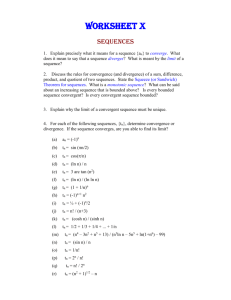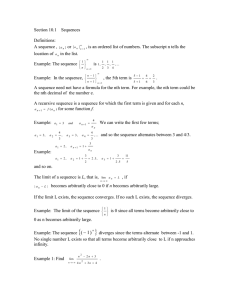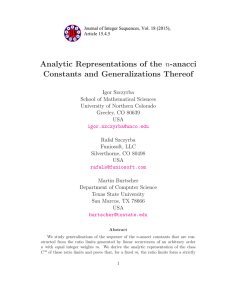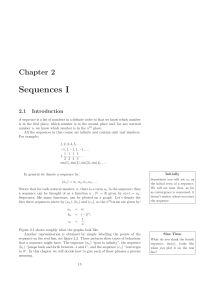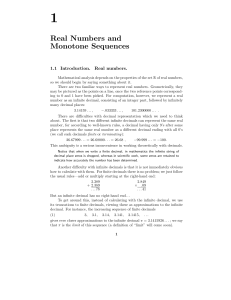Problem sheet 5 29. Can you find a recurrence relation which
advertisement
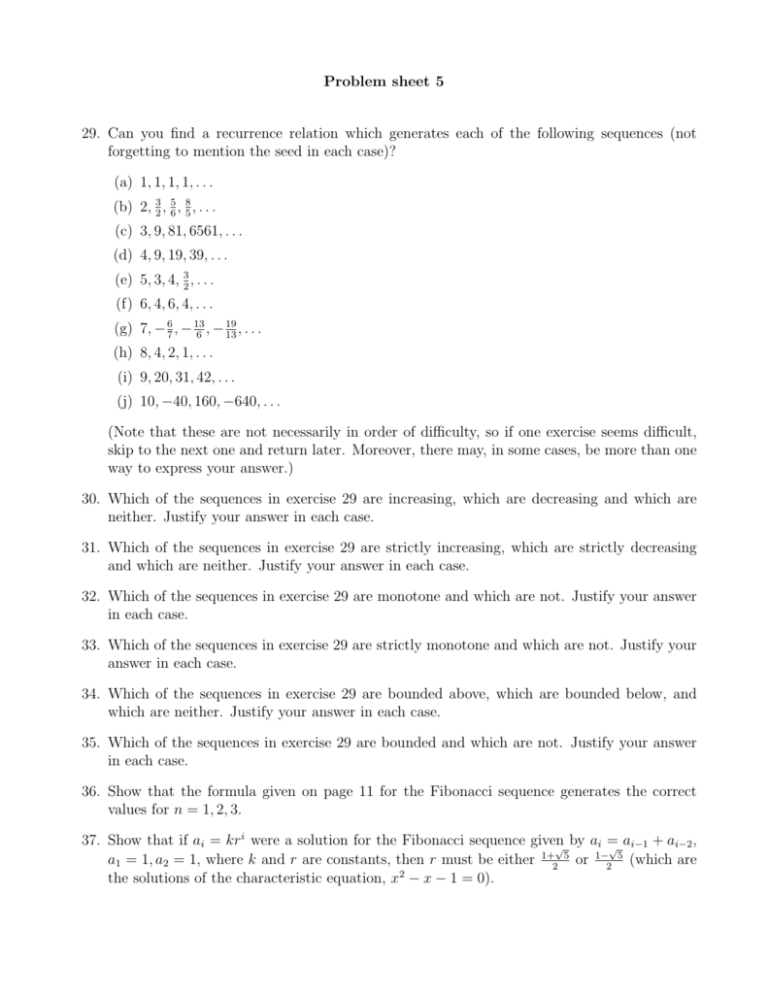
Problem sheet 5 29. Can you find a recurrence relation which generates each of the following sequences (not forgetting to mention the seed in each case)? (a) 1, 1, 1, 1, . . . (b) 2, 32 , 56 , 85 , . . . (c) 3, 9, 81, 6561, . . . (d) 4, 9, 19, 39, . . . (e) 5, 3, 4, 32 , . . . (f) 6, 4, 6, 4, . . . (g) 7, − 76 , − 13 , − 19 ,... 6 13 (h) 8, 4, 2, 1, . . . (i) 9, 20, 31, 42, . . . (j) 10, −40, 160, −640, . . . (Note that these are not necessarily in order of difficulty, so if one exercise seems difficult, skip to the next one and return later. Moreover, there may, in some cases, be more than one way to express your answer.) 30. Which of the sequences in exercise 29 are increasing, which are decreasing and which are neither. Justify your answer in each case. 31. Which of the sequences in exercise 29 are strictly increasing, which are strictly decreasing and which are neither. Justify your answer in each case. 32. Which of the sequences in exercise 29 are monotone and which are not. Justify your answer in each case. 33. Which of the sequences in exercise 29 are strictly monotone and which are not. Justify your answer in each case. 34. Which of the sequences in exercise 29 are bounded above, which are bounded below, and which are neither. Justify your answer in each case. 35. Which of the sequences in exercise 29 are bounded and which are not. Justify your answer in each case. 36. Show that the formula given on page 11 for the Fibonacci sequence generates the correct values for n = 1, 2, 3. 37. Show that if ai = kri were a solution for the Fibonacci sequence given by ai = a + ai−2 , √ i−1 √ 1− 5 1+ 5 a1 = 1, a2 = 1, where k and r are constants, then r must be either 2 or 2 (which are the solutions of the characteristic equation, x2 − x − 1 = 0). √ √ 38. Let p = 1+2 5 and q = 1−2 5 be the two solutions of the characteristic equation just mentioned (where p > q). Show that p + q = 1 and pq = −1. 39. Expand (p2 − q 2 )(p + q) and hence show that p3 − q 3 = p2 − q 2 + p − q. 40. Show, likewise, that p4 − q 4 = p3 − q 3 + p2 − q 2 41. Show, in general, that pi − q i = pi−1 − q i−1 + pi−2 − q i−2 , where i ≥ 2. n √ n √ n o 1+ 5 . Show that b1 = b2 = 1. (Have you seen this before?) 42. Let bn = √15 − 1−2 5 2 43. Finally prove that bn = an ∀n 44. The Lucas numbers are given by ai = ai−1 + ai−2 , a1 = 2, a2 = 1. Write down the first ten terms. Try to find ai explicitly. 45. Construct a sequence of numbers from our set, S, which converges to 25 . Calculate the first eight terms of this sequence. 46. Repeat exercise 45 for the fraction 25 . 17 47. Repeat exercise 45 for the irrational number 48. Repeat exercise 45 for the irrational number √ √ 3. 5.



